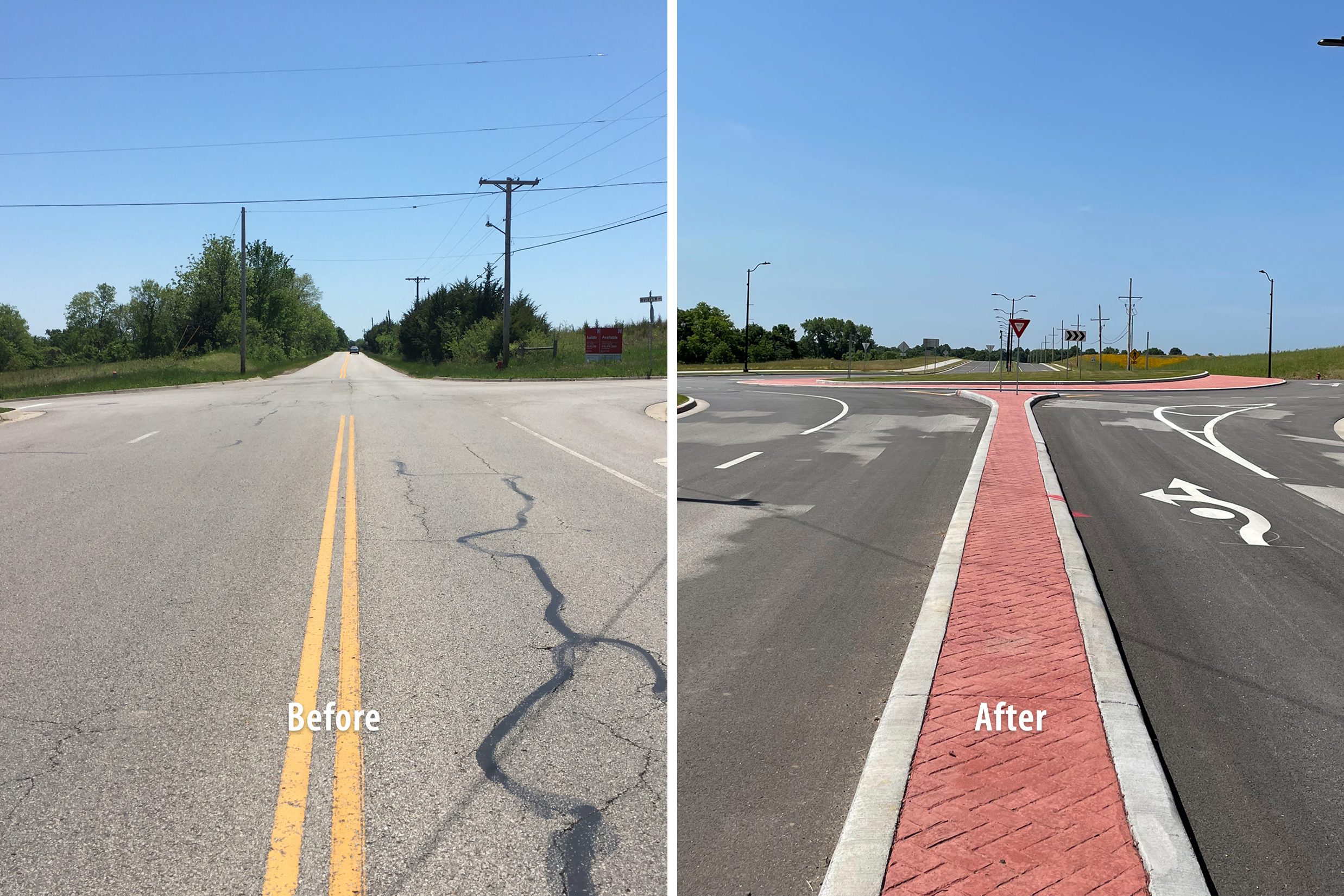Sharing the Road: How to Make Our Roadways Safe

Every day, millions of people rely on our roadways to navigate their daily lives. From commuting to work and school to running errands and embarking on road trips, our roads serve as the lifelines of our modern society. Keeping our roadways safe plays a crucial role in the prevention of tragic accidents and injuries. According to the National Highway Traffic Safety Administration (NHTSA), there were 6.1 million reported motor vehicle crashes in 2021. Of these crashes, almost 2.5 million resulted in injury. It’s almost every day that we hear about or see a car crash occur. We have gotten so used to seeing these accidents on the road, we often forget the potential severity of a collision; thinking first of our destination, or how we can make up the time. At the end of the day, being late to an event is a far better alternative than the tragic injury that could result from someone speeding, not paying attention, or poor infrastructure design. This is why the BHC public works team focuses on traffic studies and roadway design.
Our team is always working to improve safety and create more efficient roadways. In recent years, BHC completed the Safe Routes to School project, a 3,600 FT stretch that included the addition of sidewalk, curb, gutter, and driveways within a residential area. The routes provided students and families a safe space to walk to and from school, with paths to White Elementary, Willard Elementary, and West Middle school, all in Kansas City, Kansas. BHC is also involved with the 47th Street Complete Streets project, in conjunction with the City of Westwood, Roeland Park, and the Unified Government of Wyandotte County/Kansas City, Kansas. The planned improvements will create a much safer and welcoming environment within the corridor, ensuring that our communities can stay out of harm’s way, while enhancing the aesthetics of the area. From encouraging an advancement in car technology to infrastructure development, we aim to create a safer environment for all road users.
Advanced Technology in Cars
Safer cars and innovative technology have been pivotal in protecting drivers, pedestrians, and other vehicles on the road. Modern vehicle advancements and systems play a crucial role in promoting vehicle control, driver alertness, and compliance with traffic rules, leading to a safer road and the reduction of accidents and fatalities.
In recent years, there have been many reliable improvements to systems in cars. Advanced Driver Assistance Systems (ADAS), for example, can prevent accidents by acting as a protective safeguard. With the use of sensors and cameras, these systems work by monitoring the vehicle’s surroundings and notifying the driver during moments that could be dangerous. Another recent addition to modern cars has been the blind spot detection feature. Cameras will sense and alert the driver when another vehicle is in the driver’s blind spot, assisting in safer lane changes. This blind spot feature detects those vehicles ahead of time so we, as the driver, can easily prevent these accidents from happening. Each of these advancements has helped prevent collisions, but it is crucial to acknowledge that ensuring the safety of our roadways requires the consideration of numerous other preventative measures.
Traffic Calming Devices
Traffic calming devices are effective tools when improving roadways by managing traffic flow, reducing speed, and increasing driver awareness. Certain infrastructure developments effectively grab the attention of drivers, encouraging them to slow their speed. Specific examples of these devices are speed cushions, speed bumps, and speed humps. Speed bumps are generally taller while speed humps have a more gradual slope. They are commonly found in neighborhoods, parking lots, school zones, and other busy areas where residents may be present, aiming to protect drivers, cyclists, and pedestrians alike. This can reduce the number of injuries caused by these easily preventable accidents.
Raised crosswalks are another effective traffic calming device. An addition like this can eliminate interruptions caused by both drivers and pedestrians, separating them so neither is forced to wait on the other. They eliminate conflicts, reducing the risk of accidents and enhancing safety everyone on or near the roadway. Additionally, raised crosswalks provide a more convenient way of navigation for pedestrians, reducing congestion in the street. These crosswalks are useful in more urban areas with multimodal transportation. Raised crosswalks interconnect important places and promote easy access for short-distance trips, further encouraging walking over driving. By implementing devices like these, our community can reduce accidents and injuries, promote sustainable transportation options, and create a safer environment for everyone on the road.
Infrastructure Development
Infrastructure development is another critical aspect of improving road safety. Designing bike lanes, trails, and raised walkways creates a safer environment for pedestrians. Additionally, infrastructure improvements such as diverging diamond interchanges and roundabouts can not only enhance traffic flow but overall safety. There is nothing worse than when you are running late for work and hit every red light on your way. Both roundabouts and diverging diamonds are helpful in managing traffic flow without forcing either side of the road to stop. These replacements to traditional intersections can be helpful in high traffic areas. Well-designed infrastructure provides separate spaces for various road users, reducing potential conflicts and collisions. One recent example is BHC’s work on the Riverview Crossroads in Edwardsville, Kansas. This project includes roadway improvements to 110th Street and Riverview Avenue in support of an upcoming commercial and industrial development. Both streets have been widened, increasing the ability to manage a high volume of vehicles, and a roundabout has been added at the intersection, allowing for a more efficient flow of traffic.
Infrastructure development also focuses on improvement such as road geometry and design. Elements like road width, sight distances, well-designed road signs, clear road markings, and lighting systems can help drivers to be more alert, reducing the risk of accidents. Along with these design elements, it is also important to have well-maintained and paved roadways so vehicles can have good traction during harsh weather conditions. Our team is made up of experts across all facets of public works, including stormwater. If water is not diverted properly or quickly enough, it can settle on the roads causing drivers to hydroplane. Not only is this a danger to drivers in the moment, but standing water also damages roads and creates potholes. We recognize the impact that infrastructure development has on our communities, and work every day to ensure that these environments are as safe and efficient as possible.
Speed Management
We often underestimate the dangers that can be associated with speed, but it is important to recognize that speed can have devastating consequences on our roadways. Speed limits are carefully determined with the goal of protecting the lives of all road users and should not be taken lightly. They are based on many factors such as road design, traffic flow, legal requirements, and pedestrian activity. These limits are intended to promote safe and responsible driving behaviors, ultimately creating a safer environment for everyone on the road. Drivers can decrease the likelihood of accidents and protect themselves and others by adhering to the set speed limit. It may be easier said than done sometimes, but it is important to pay attention to speed limits for it is a simple yet effective way to keep our roads safe. The relationship between speed and crash risk is undeniable. As the speed of a vehicle increases, so does the likelihood of an accident occurring. Speed management strategies, such as speed enforcement and public awareness campaigns, are crucial in reducing the number of accidents and ensuring the safety of road users. It is imperative for drivers to stay alert to speed limits and adjust their driving behavior accordingly.
Vision Zero
The Vision Zero Network is a strategic campaign that aims to eliminate all traffic fatalities and injuries, keeping our roads safe. It is unacceptable for there to be even one death resulting from a traffic incident. Vision Zero encourages collaboration among many stakeholders to save lives. By adopting a holistic approach, including advanced technology, infrastructure development, speed management, and community engagement, Vision Zero strives to create a safer environment for all road users. Specifically in Kansas City, the introduction of the streetcar and scooter rentals were the first step in providing safe, multimodal transportation. Moving forward, we can expect roadway improvements to intersections, traffic signal updates, and improved traffic calming guidelines, among other things.
Wrap-up
Ensuring the safety of our roadways requires a multifaceted approach that encompasses advanced technology, traffic calming devices, infrastructure development, and speed management. By embracing these strategies along with Vision Zero, a safer environment for all road users can be created. It is only through our collective efforts that we can eliminate motor vehicle incidents, and prevent the tragic consequences that result from them. Let us prioritize safe roads, safe speeds, and safe vehicles to strive for zero fatalities in our community and beyond.
From project conception to completion, you can count on BHC to get the work done. Our ‘No Problem’ approach to challenges allows us to provide excellent customer service and resolutions for your projects. To view our project portfolio, visit ibhc.com/service/public-works/. Visit our connect page to get in touch with one of our traffic engineering experts and expand your network today.
